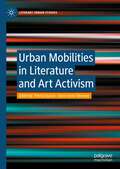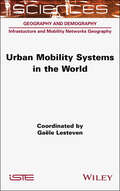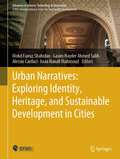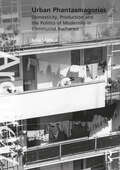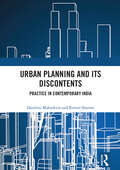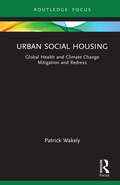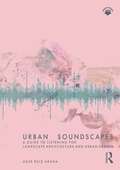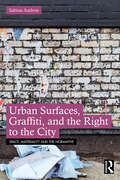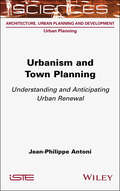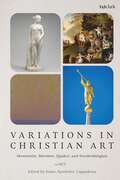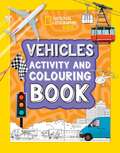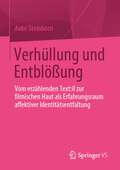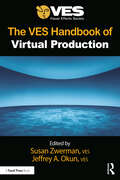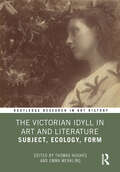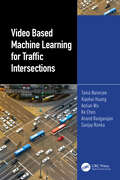- Table View
- List View
Urban Mobilities in Literature and Art Activism (Literary Urban Studies)
by Patricia García Anna-Leena ToivanenUrban Mobilities in Literature and Art Activism explores the entwinement of mobility and immobility in urban spaces by focusing on their representation in literary narratives but also in visual and performing arts. Across a range of geographical contexts, this volume builds on the new mobilities paradigm developed by literary scholars, sociologists and human geographers. The different chapters employ a cohesive framework that is sensitive to the intersecting dimensions of power and discrimination that shape urban kinetic features. The contributions are divided into three sections, each of which places the focus on a different aspect of urban mobility: Itinerant Subjects, Modes of Transport and Places of Transit, and Urban Liminalities.Chapter 7, "Alienation, Abjection and the Mobile Postcolonial City: Public Transport in Ousmane Sembène’s “Niiwam” and Yvonne Vera’s Without a Name" is available open access under a Creative Commons Attribution 4.0 International License via link.springer.com.
Urban Mobility Systems in the World
by Gaele LestevenUrban Mobility Systems in the World provides insight into the geographical organization of urban mobility systems around the world. These “systems” consist of infrastructure networks, existing transport services and people’s travel practices. Adopting a comparative approach, the book highlights the geographical diversity of mobility systems, based on case studies from Africa, North and South America, Asia and Europe. This multi-disciplinary book is organized into twelve chapters, divided into four parts. The first part gives an overview of urban mobility, and then examines the factors that determine everyday mobility in cities, revealing different travel practices among populations (poor, elderly and children). Parts 2 and 3, respectively, focus on urban public transport (trains, metros, minibuses) and active modes of transport (walking, cycling), and the related infrastructure policies. The final section examines the circulation of urban mobility analysis tools and public policy models
Urban Mobility Systems in the World
by Gaële LestevenUrban Mobility Systems in the World provides insight into the geographical organization of urban mobility systems around the world. These “systems” consist of infrastructure networks, existing transport services and people’s travel practices. Adopting a comparative approach, the book highlights the geographical diversity of mobility systems, based on case studies from Africa, North and South America, Asia and Europe. This multi-disciplinary book is organized into twelve chapters, divided into four parts. The first part gives an overview of urban mobility, and then examines the factors that determine everyday mobility in cities, revealing different travel practices among populations (poor, elderly and children). Parts 2 and 3, respectively, focus on urban public transport (trains, metros, minibuses) and active modes of transport (walking, cycling), and the related infrastructure policies. The final section examines the circulation of urban mobility analysis tools and public policy models
Urban Narratives: Exploring Identity, Heritage, and Sustainable Development in Cities (Advances in Science, Technology & Innovation)
by Mohd Fairuz Shahidan Gasim Hayder Ahmed Salih Alessio Cardaci Israa Hanafi MahmoudThis book engages readers in an enlightening exploration of cities' identities, sustainability, and urban development. Delving into the intricate interplay between art, architecture, and the urban landscape, it offers a compelling analysis of the factors that shape cities and their distinct personalities. The volume uncovers captivating stories of cities as they navigate the delicate balance between heritage conservation and modernity. It highlights innovative strategies employed to preserve historical sites while adapting to the demands of a rapidly changing world. Full of insightful discussions on the impact of cultural lifestyles, the fusion of architectural styles, and the challenges and triumphs of sustainable urban development, it draws upon a diverse range of perspectives and research, inviting architects, urban planners, and scholars to delve into the intricate nuances of cities' identities in the process.With its informative and engaging narrative, this book providesa fresh perspective on cities' identities and offers practical insights into shaping vibrant, livable urban landscapes.
Urban Phantasmagorias: Domesticity, Production and the Politics of Modernity in Communist Bucharest (Architext)
by Iulia StăticăUrban Phantasmagorias examines the legacies of socialist housing in the city of Bucharest during the period of communist rule in Romania. The book explores the manner in which the socialist state reconfigured the city through concrete acts of demolition and construction, as well as indirectly through legal frameworks aimed at the regulation of women’s reproductive agency, in an attempt to materialize its idea of modernity. It follows the effects of this state agenda with a focus on the period between 1965 and 1989 through an investigation of the transformations, representations, meanings, and uses of domestic spaces. The book draws on Walter Benjamin’s concept of phantasmagoria, which provides a critical framework through which it articulates the dynamic relationship between ideology, architecture, and everyday practices, and reassesses their impact upon individual subjectivity and agency. The woman emerges as a central subject of the book, upon whom the phantasmagoric effects of the socialist state’s modernizing agenda have an acute impact at the level of lived domesticity and everyday life. Through a focus on the lived experiences of women, the book illuminates the prismatic effect of the state’s infrastructural and legal intentions, including the ways in which these were subverted through women’s lived bodily experiences of the home. The book establishes, both theoretically and through the concrete case of the city of Bucharest, the methodological significance of Benjamin’s notion of phantasmagoria as an epistemological approach to a modern communist cityscape. Urban Phantasmagorias is an important contribution to scholarship in architectural history and theory, urban and gender studies, and post-socialist and Eastern European studies.
Urban Phantasmagorias: Domesticity, Production and the Politics of Modernity in Communist Bucharest (Architext)
by Iulia StăticăUrban Phantasmagorias examines the legacies of socialist housing in the city of Bucharest during the period of communist rule in Romania. The book explores the manner in which the socialist state reconfigured the city through concrete acts of demolition and construction, as well as indirectly through legal frameworks aimed at the regulation of women’s reproductive agency, in an attempt to materialize its idea of modernity. It follows the effects of this state agenda with a focus on the period between 1965 and 1989 through an investigation of the transformations, representations, meanings, and uses of domestic spaces. The book draws on Walter Benjamin’s concept of phantasmagoria, which provides a critical framework through which it articulates the dynamic relationship between ideology, architecture, and everyday practices, and reassesses their impact upon individual subjectivity and agency. The woman emerges as a central subject of the book, upon whom the phantasmagoric effects of the socialist state’s modernizing agenda have an acute impact at the level of lived domesticity and everyday life. Through a focus on the lived experiences of women, the book illuminates the prismatic effect of the state’s infrastructural and legal intentions, including the ways in which these were subverted through women’s lived bodily experiences of the home. The book establishes, both theoretically and through the concrete case of the city of Bucharest, the methodological significance of Benjamin’s notion of phantasmagoria as an epistemological approach to a modern communist cityscape. Urban Phantasmagorias is an important contribution to scholarship in architectural history and theory, urban and gender studies, and post-socialist and Eastern European studies.
Urban Planning and its Discontents: Practice in Contemporary India
by Darshini Mahadevia Rutool SharmaThis book, the first of its kind, introduces various aspects of urban planning in India and contributes towards debates on changes required in the current practice. Urban planning in India means many things to city residents and is used generically to include all interventions in the cities, such as public policy design, institutional design, spatial and territorial plans, infrastructure plans, public administration, community participation, and their implementation through programmes, schemes, and projects. While urban planning is expected to meet the global development agendas of equitable and just urbanisation, climate change and sustainable development goals (SDGs), in practice it has largely remained confined to statutory spatial planning represented by ‘Master Plan’ or ‘Comprehensive Plan’. This volume delves into this world of urban planning as critical insiders to see how it works in India, analysing the city level spatial plans, the Master or Development Plans, of select cities to assess whether these are capable of addressing the global agendas and coordinate with all other plans prepared for the city. It examines whether it would work in reference to the contemporary issues, SDGs, and global agendas, and discusses strategies on how to make it work better. It also deals with each of the above stated criticisms of the practice and examines the debates, data, approaches, agendas, plans, and the future of urban planning in India. This book comes in at a time when the urban planners and policy makers have themselves begun to discuss a need to relook at urban planning practices and tools to meet the future requirements of urbanisation in India. It will be a useful reference volume for the students, scholars and practitioners alike, and be of interest to researchers and students of urban planning, architecture, public administration, civil engineering, geography, economics, and sociology. It will also be useful for policy makers and professionals working in the areas of town and country planning.
Urban Planning and its Discontents: Practice in Contemporary India
by Darshini Mahadevia Rutool SharmaThis book, the first of its kind, introduces various aspects of urban planning in India and contributes towards debates on changes required in the current practice. Urban planning in India means many things to city residents and is used generically to include all interventions in the cities, such as public policy design, institutional design, spatial and territorial plans, infrastructure plans, public administration, community participation, and their implementation through programmes, schemes, and projects. While urban planning is expected to meet the global development agendas of equitable and just urbanisation, climate change and sustainable development goals (SDGs), in practice it has largely remained confined to statutory spatial planning represented by ‘Master Plan’ or ‘Comprehensive Plan’. This volume delves into this world of urban planning as critical insiders to see how it works in India, analysing the city level spatial plans, the Master or Development Plans, of select cities to assess whether these are capable of addressing the global agendas and coordinate with all other plans prepared for the city. It examines whether it would work in reference to the contemporary issues, SDGs, and global agendas, and discusses strategies on how to make it work better. It also deals with each of the above stated criticisms of the practice and examines the debates, data, approaches, agendas, plans, and the future of urban planning in India. This book comes in at a time when the urban planners and policy makers have themselves begun to discuss a need to relook at urban planning practices and tools to meet the future requirements of urbanisation in India. It will be a useful reference volume for the students, scholars and practitioners alike, and be of interest to researchers and students of urban planning, architecture, public administration, civil engineering, geography, economics, and sociology. It will also be useful for policy makers and professionals working in the areas of town and country planning.
Urban Social Housing: Global Health and Climate Change Mitigation and Redress
by Patrick WakelyThis book proposes operational approaches to public sector support to community-led development of urban low-income group social housing in the prevailing and medium-term. Within the context of mitigating and redressing the existential threats of climate change and global pathogenic transmission, building on current concerns of global heating and the lessons learnt from the 2020-22 COVID-19 pandemic, the book closely examines recent examples from a wide international range of countries and cities from the Sri Lanka experience to Arab States of the Middle East and the Andes. Topics include maintenance and management of public sector housing, poverty alleviation objectives, climate change mitigation, housing density, local land management and planning, land rights, affordable housing markets, and international governance and administration, ultimately pointing to the universal need for institutional, organisational and human skills development and the compilation and dissemination of operationally successful examples of participatory partnerships for affordable social housing. The book will be of interest to researchers, instructors, practitioners, and students of urban development, housing, environmental design, land-use planning, public administration and environmental health engineering.
Urban Social Housing: Global Health and Climate Change Mitigation and Redress
by Patrick WakelyThis book proposes operational approaches to public sector support to community-led development of urban low-income group social housing in the prevailing and medium-term. Within the context of mitigating and redressing the existential threats of climate change and global pathogenic transmission, building on current concerns of global heating and the lessons learnt from the 2020-22 COVID-19 pandemic, the book closely examines recent examples from a wide international range of countries and cities from the Sri Lanka experience to Arab States of the Middle East and the Andes. Topics include maintenance and management of public sector housing, poverty alleviation objectives, climate change mitigation, housing density, local land management and planning, land rights, affordable housing markets, and international governance and administration, ultimately pointing to the universal need for institutional, organisational and human skills development and the compilation and dissemination of operationally successful examples of participatory partnerships for affordable social housing. The book will be of interest to researchers, instructors, practitioners, and students of urban development, housing, environmental design, land-use planning, public administration and environmental health engineering.
Urban Soundscapes: A Guide to Listening for Landscape Architecture and Urban Design
by Usue Ruiz AranaSound and listening are intrinsically linked to how we experience and engage with places and communities. This guide puts forward a new conceptual framework of embodied affectivity that emphasises listening in urban research and design and advances new ways of knowing and making. The guide invites landscape architects and urban designers to become soundscape architects and offers practical advice on sound and listening applicable to each stage of a design project: from reading the environment to intervening on it.Urban Soundscapes foregrounds listening as an affective mediator between subjects and multispecies environments, and a vehicle to think and conceptualise environmental research and design beyond prevailing visual and human-centred modes. The guide expands landscape architects’ and urban designers’ tools and skills to assess existing soundscapes, predict how those soundscapes will be altered through their designs, consider sound as a creative and active part of the design process and envisage how users might perceive and be affected by those soundscapes as they evolve in time. The volume sits in the interface of research and practice and interweaves theoretical, methodological and creative contributions from acoustic ecology, ecoacoustics, bioacoustics and sound art. Each of the design stages is illustrated through project examples that demonstrate the many advantages of incorporating attentive listening and sound into Landscape Architecture and Urban Design Practice. This book shows how incorporating listening and sounding as part of the design process promotes slow and subtle ways of practice, adds social and ecological value through the reduction of noise pollution and by monitoring the health of habitats, and enables the design of soundscapes that complement the character and design intent of a scheme and elicit joy and wonder.The book will be of interest to practitioners and academics in landscape architecture, and other design and spatial fields such as urban design, architecture, geography and engineering, who play a primary role in the composition of the soundscape.
Urban Soundscapes: A Guide to Listening for Landscape Architecture and Urban Design
by Usue Ruiz AranaSound and listening are intrinsically linked to how we experience and engage with places and communities. This guide puts forward a new conceptual framework of embodied affectivity that emphasises listening in urban research and design and advances new ways of knowing and making. The guide invites landscape architects and urban designers to become soundscape architects and offers practical advice on sound and listening applicable to each stage of a design project: from reading the environment to intervening on it.Urban Soundscapes foregrounds listening as an affective mediator between subjects and multispecies environments, and a vehicle to think and conceptualise environmental research and design beyond prevailing visual and human-centred modes. The guide expands landscape architects’ and urban designers’ tools and skills to assess existing soundscapes, predict how those soundscapes will be altered through their designs, consider sound as a creative and active part of the design process and envisage how users might perceive and be affected by those soundscapes as they evolve in time. The volume sits in the interface of research and practice and interweaves theoretical, methodological and creative contributions from acoustic ecology, ecoacoustics, bioacoustics and sound art. Each of the design stages is illustrated through project examples that demonstrate the many advantages of incorporating attentive listening and sound into Landscape Architecture and Urban Design Practice. This book shows how incorporating listening and sounding as part of the design process promotes slow and subtle ways of practice, adds social and ecological value through the reduction of noise pollution and by monitoring the health of habitats, and enables the design of soundscapes that complement the character and design intent of a scheme and elicit joy and wonder.The book will be of interest to practitioners and academics in landscape architecture, and other design and spatial fields such as urban design, architecture, geography and engineering, who play a primary role in the composition of the soundscape.
Urban Surfaces, Graffiti, and the Right to the City (ISSN)
by Sabina AndronThis landmark book focuses on urban surfaces, on exploring their authorship and management, and on their role in struggles for the right to the city.Graffiti, pristine walls, advertising posters, and municipal signage all compete on city surfaces to establish and imprint their values on our environments. It is the first time that the surfacescapes of our cities are granted the entire attention of a book as material, visual, and legal territories. The book includes a critical history of graffiti and street art as contested surface discourses and argues for surfaces as sites of resistance against private property, neoliberal creativity, and the imposition of urban order. It also proposes a seven-point manual for a semiotics of urban surfaces, laying the ground for a new discipline: surface studies.Page after page and layer after layer, surfaces become porous and political and emerge as key spatial conditions for rethinking and re-practicing urban dwelling and spatial justice. They become what the author terms the surface commons.The book will appeal to a wide readership across the disciplines of urban studies, architectural theory and design, graffiti, street art and public art, criminology, semiotics, visual culture, and urban and legal geography. It will also serve as a tool for city scholars, policy makers, artists, and vandals to disrupt existing imaginaries of order, justice, and visibility in cities.
Urban Surfaces, Graffiti, and the Right to the City (ISSN)
by Sabina AndronThis landmark book focuses on urban surfaces, on exploring their authorship and management, and on their role in struggles for the right to the city.Graffiti, pristine walls, advertising posters, and municipal signage all compete on city surfaces to establish and imprint their values on our environments. It is the first time that the surfacescapes of our cities are granted the entire attention of a book as material, visual, and legal territories. The book includes a critical history of graffiti and street art as contested surface discourses and argues for surfaces as sites of resistance against private property, neoliberal creativity, and the imposition of urban order. It also proposes a seven-point manual for a semiotics of urban surfaces, laying the ground for a new discipline: surface studies.Page after page and layer after layer, surfaces become porous and political and emerge as key spatial conditions for rethinking and re-practicing urban dwelling and spatial justice. They become what the author terms the surface commons.The book will appeal to a wide readership across the disciplines of urban studies, architectural theory and design, graffiti, street art and public art, criminology, semiotics, visual culture, and urban and legal geography. It will also serve as a tool for city scholars, policy makers, artists, and vandals to disrupt existing imaginaries of order, justice, and visibility in cities.
Urbanism and Town Planning: Understanding and Anticipating Urban Renewal
by Jean-Philippe AntoniSustainable urban planning and urban renewal are major challenges of the 21st century. In this context, Urbanism and Town Planning proposes a geohistorical approach to urban construction. The city and its neighborhoods are studied through their materials and general layout, which sometimes reveal a logic of economic profitability, prestige and social equity, and sometimes a more innovative approach from an environmental perspective. Across these elements, unbuilt spaces (distinctive streets and squares) and built spaces (commercial and residential areas, both individual and collective) form a three-dimensional grid of “voids” and “solids”, characteristic of urban landscapes and lifestyles. Supported by numerous original examples, this book is a comprehensive summary of the most tangible elements of urban planning and development; elements that must be put into context in order to think concretely about the development of the cities of the future.
Urbanism and Town Planning: Understanding and Anticipating Urban Renewal
by Jean-Philippe AntoniSustainable urban planning and urban renewal are major challenges of the 21st century. In this context, Urbanism and Town Planning proposes a geohistorical approach to urban construction. The city and its neighborhoods are studied through their materials and general layout, which sometimes reveal a logic of economic profitability, prestige and social equity, and sometimes a more innovative approach from an environmental perspective. Across these elements, unbuilt spaces (distinctive streets and squares) and built spaces (commercial and residential areas, both individual and collective) form a three-dimensional grid of “voids” and “solids”, characteristic of urban landscapes and lifestyles. Supported by numerous original examples, this book is a comprehensive summary of the most tangible elements of urban planning and development; elements that must be put into context in order to think concretely about the development of the cities of the future.
Variations in Christian Art: Mennonite, Mormon, Quaker, and Swedenborgian
by Diane Apostolos-CappadonaThe artistic traditions of four major Christian denominations are examined and outlined in detail in this groundbreaking volume that presents the first synthesis of the artistic contributions of those traditions. Diane Apostolos-Cappadona has curated a volume that presents four single-authored contributions in one place, broadening the study of Christian art beyond Roman Catholic, Orthodox and 'protestant' traditions to consider these more recent Christian approaches in close and expert detail. Rachel Epp Buller examines art in the Mennonite tradition, Mormon art is considered by Heather Belnap, Quaker contributions by Rowena Loverance and Swedenborgian art by Diane Apostolos-Cappadona. Each writer presents elements of the theology of their chosen tradition through the prism of the artists and artistic works that they have selected. Alongside mainstream artistic figures such as William Blake less known figures come to the fore and the volume features color illustrations that support and underline the theological and artistic themes presented in each section of the book. Together these studies of artistic presentations in these four traditions will be a much need means of filling a gap in the study of Christian art.
Verhüllung und Entblößung: Vom erzählenden Text:il zur filmischen Haut als Erfahrungsraum affektiver Identitätsentfaltung
by Anke SteinbornDieses Buch enthält eine interdisziplinäre Betrachtung zum identitätsbildenden Wechselspiel von Text, Textilem und der Haut im und über den Film. Kernthese ist die Überlegung, dass sich im Film über den Wechsel zwischen Textilem und nackter Haut ikonische Verdichtungen zugunsten eines assoziativen Erfahrungsraums entfalten. Dabei weicht der Stoff – der erzählerische gleichermaßen wie der textile – dem Sinnlichen, der Affizierung über die Haut. Die Untersuchung beleuchtet den Zusammenhang zwischen filmischer Rezeption und Selbstreflexion der Zuschauenden, aber auch einer Gesellschaft sowie des Films selbst im jeweils zeitlichen Kontext. Die Filmsehenden erfahren nicht nur das Geschehen und die Protagonist*innen, sondern vor allem auch sich selbst im Spiegel des Anderen – der anderen Figur, der anderen Geschichte, der anderen, filmischen Welt. Ziel der Untersuchung ist es, unter symbolische Hüllen zu schauen und das Wesentliche darunter zu entdecken. Durch die Interdisziplinarität der Arbeit werden nicht nur Interessierte der Film-, Medien- und Kulturwissenschaft, sondern auch der Soziologie, der Psychologie, des (Mode-)Designs, der Kunstgeschichte und der Architektur angesprochen. Das Buch regt zu Perspektivwechseln und interdisziplinärem Austausch auf der Basis der für uns alle existenziellen Haut an. Mit diesem Alleinstellungsmerkmal werden Grenzen überwunden und Kollaborationen angeregt.
The VES Handbook of Virtual Production
The VES Handbook of Virtual Production is a comprehensive guide to everything about virtual production available today – from pre-production to digital character creation, building a stage, choosing LED panels, setting up Volume Control, in-camera compositing of live action and CG elements, Virtual Art Departments, Virtual Previs and scouting, best practices and much more.Current and forward-looking, this book covers everything one may need to know to execute a successful virtual production project – including when it is best to use virtual production and when it is not. More than 80 industry leaders in all fields of virtual production share their knowledge, experiences, techniques, and best practices. The text also features charts, technical drawings, color images, and an extensive glossary of virtual production terms.The VES Handbook of Virtual Production is a vital resource for anyone wishing to gain essential knowledge in all aspects of virtual production. This is a must-have book for both aspiring and veteran professionals. It has been carefully compiled by the editors of The VES Handbook of Visual Effects.
The VES Handbook of Virtual Production
by Susan Zwerman Jeffrey A. Okun Susan Thurmond O’NealThe VES Handbook of Virtual Production is a comprehensive guide to everything about virtual production available today – from pre-production to digital character creation, building a stage, choosing LED panels, setting up Volume Control, in-camera compositing of live action and CG elements, Virtual Art Departments, Virtual Previs and scouting, best practices and much more.Current and forward-looking, this book covers everything one may need to know to execute a successful virtual production project – including when it is best to use virtual production and when it is not. More than 80 industry leaders in all fields of virtual production share their knowledge, experiences, techniques, and best practices. The text also features charts, technical drawings, color images, and an extensive glossary of virtual production terms.The VES Handbook of Virtual Production is a vital resource for anyone wishing to gain essential knowledge in all aspects of virtual production. This is a must-have book for both aspiring and veteran professionals. It has been carefully compiled by the editors of The VES Handbook of Visual Effects.
The Victorian Idyll in Art and Literature: Subject, Ecology, Form (Routledge Research in Art History)
by Thomas Hughes Emma MerklingResonating with contemporary ecological and queer theory, this book pioneers the theorization of the Victorian idyll, establishing its nature, lineaments, and significance as a formal mode widely practised in nineteenth-century British culture across media and genre. Chapters trace the Victorian idyll’s emergence in the 1830s, its flourishing in the 1860s, and its evolution up to the century’s close, drawing attention to the radicalism of idyllic experiments with pictorial, photographic, dramatic, literary, and poetic form in the work of canonical and lesser-known figures. Approaching the idyll through three intersecting categories—subject, ecology, and form—this book remaps Victorian culture, reshaping thinking about artistic form in the nineteenth century, and recalibrating accepted chronologies. In the representations by a host of Victorian artists and writers engaging with other-than-human forms, and in the natures of the subjectivities animated by these encounters, we find versions of Victorian ecology providing provocative imaginative material for ecocritics, scholars, writers, and artists today. This book will be of interest to scholars working in art history, English literature, Victorian studies, British history, queer and trans* theory, musicology, and ecocriticism, and will enliven debates pertaining to the environmental across periods.
The Victorian Idyll in Art and Literature: Subject, Ecology, Form (Routledge Research in Art History)
Resonating with contemporary ecological and queer theory, this book pioneers the theorization of the Victorian idyll, establishing its nature, lineaments, and significance as a formal mode widely practised in nineteenth-century British culture across media and genre. Chapters trace the Victorian idyll’s emergence in the 1830s, its flourishing in the 1860s, and its evolution up to the century’s close, drawing attention to the radicalism of idyllic experiments with pictorial, photographic, dramatic, literary, and poetic form in the work of canonical and lesser-known figures. Approaching the idyll through three intersecting categories—subject, ecology, and form—this book remaps Victorian culture, reshaping thinking about artistic form in the nineteenth century, and recalibrating accepted chronologies. In the representations by a host of Victorian artists and writers engaging with other-than-human forms, and in the natures of the subjectivities animated by these encounters, we find versions of Victorian ecology providing provocative imaginative material for ecocritics, scholars, writers, and artists today. This book will be of interest to scholars working in art history, English literature, Victorian studies, British history, queer and trans* theory, musicology, and ecocriticism, and will enliven debates pertaining to the environmental across periods.
Video Based Machine Learning for Traffic Intersections
by Tania Banerjee Xiaohui Huang Aotian Wu Ke Chen Anand Rangarajan Sanjay RankaVideo Based Machine Learning for Traffic Intersections describes the development of computer vision and machine learning-based applications for Intelligent Transportation Systems (ITS) and the challenges encountered during their deployment. This book presents several novel approaches, including a two-stream convolutional network architecture for vehicle detection, tracking, and near-miss detection; an unsupervised approach to detect near-misses in fisheye intersection videos using a deep learning model combined with a camera calibration and spline-based mapping method; and algorithms that utilize video analysis and signal timing data to accurately detect and categorize events based on the phase and type of conflict in pedestrian-vehicle and vehicle-vehicle interactions. The book makes use of a real-time trajectory prediction approach, combined with aligned Google Maps information, to estimate vehicle travel time across multiple intersections. Novel visualization software, designed by the authors to serve traffic practitioners, is used to analyze the efficiency and safety of intersections. The software offers two modes: a streaming mode and a historical mode, both of which are useful to traffic engineers who need to quickly analyze trajectories to better understand traffic behavior at an intersection. Overall, this book presents a comprehensive overview of the application of computer vision and machine learning to solve transportation-related problems. Video Based Machine Learning for Traffic Intersections demonstrates how these techniques can be used to improve safety, efficiency, and traffic flow, as well as identify potential conflicts and issues before they occur. The range of novel approaches and techniques presented offers a glimpse of the exciting possibilities that lie ahead for ITS research and development. Key Features: Describes the development and challenges associated with Intelligent Transportation Systems (ITS) Provides novel visualization software designed to serve traffic practitioners in analyzing the efficiency and safety of an intersection Has the potential to proactively identify potential conflict situations and develop an early warning system for real-time vehicle-vehicle and pedestrian-vehicle conflicts
Video Based Machine Learning for Traffic Intersections
by Tania Banerjee Xiaohui Huang Aotian Wu Ke Chen Anand Rangarajan Sanjay RankaVideo Based Machine Learning for Traffic Intersections describes the development of computer vision and machine learning-based applications for Intelligent Transportation Systems (ITS) and the challenges encountered during their deployment. This book presents several novel approaches, including a two-stream convolutional network architecture for vehicle detection, tracking, and near-miss detection; an unsupervised approach to detect near-misses in fisheye intersection videos using a deep learning model combined with a camera calibration and spline-based mapping method; and algorithms that utilize video analysis and signal timing data to accurately detect and categorize events based on the phase and type of conflict in pedestrian-vehicle and vehicle-vehicle interactions. The book makes use of a real-time trajectory prediction approach, combined with aligned Google Maps information, to estimate vehicle travel time across multiple intersections. Novel visualization software, designed by the authors to serve traffic practitioners, is used to analyze the efficiency and safety of intersections. The software offers two modes: a streaming mode and a historical mode, both of which are useful to traffic engineers who need to quickly analyze trajectories to better understand traffic behavior at an intersection. Overall, this book presents a comprehensive overview of the application of computer vision and machine learning to solve transportation-related problems. Video Based Machine Learning for Traffic Intersections demonstrates how these techniques can be used to improve safety, efficiency, and traffic flow, as well as identify potential conflicts and issues before they occur. The range of novel approaches and techniques presented offers a glimpse of the exciting possibilities that lie ahead for ITS research and development. Key Features: Describes the development and challenges associated with Intelligent Transportation Systems (ITS) Provides novel visualization software designed to serve traffic practitioners in analyzing the efficiency and safety of an intersection Has the potential to proactively identify potential conflict situations and develop an early warning system for real-time vehicle-vehicle and pedestrian-vehicle conflicts
